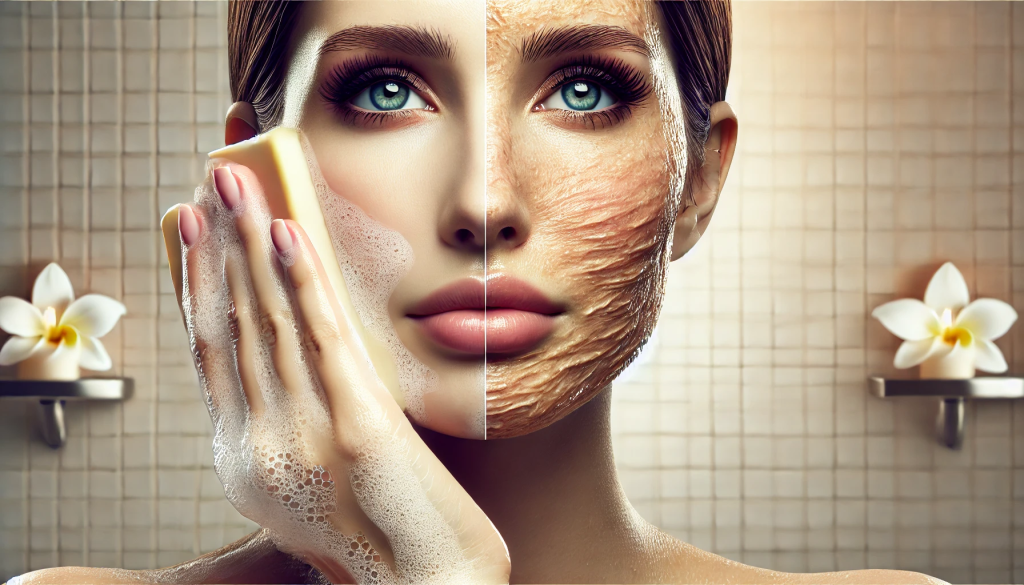Abstract: The integrity of the skin barrier is paramount for maintaining overall skin health. However, the use of inappropriate cleansers can compromise this barrier, leading to various dermatological issues. This paper explores the signs of skin barrier disruption due to harsh cleansers and provides recommendations for selecting gentle, bio-compatible alternatives. Emphasis is placed on the importance of maintaining the skin’s acid mantle and the role of ceramides in barrier repair. The discussion includes insights into the formulation of mild cleansers and highlights BioSkinetics’ HydroNexus Hydrating Liquid Facial Soap as an exemplary product.
Introduction

The skin serves as the body’s primary defense against environmental aggressors, largely due to its outermost layer, the stratum corneum. This layer functions as a barrier, preventing transepidermal water loss (TEWL) and shielding against pathogens, chemicals, and physical insults. Central to this barrier function is the skin’s acid mantle—a slightly acidic film that inhibits the proliferation of harmful microorganisms (Lambers et al., 2006). However, the use of harsh cleansers can disrupt this delicate balance, leading to compromised barrier function and subsequent skin issues.
The Skin Barrier and Its Importance
The stratum corneum comprises corneocytes embedded in a lipid matrix, primarily consisting of ceramides, cholesterol, and free fatty acids. This structure is often likened to a “brick and mortar” model, where corneocytes represent the bricks and lipids the mortar (Elias, 2005). The integrity of this arrangement is crucial for maintaining skin hydration and protecting against external irritants.
Role of the Acid Mantle
The skin’s surface pH typically ranges between 4.5 and 6.5, creating an environment that supports the resident microbiota and inhibits pathogenic organisms (Lambers et al., 2006). This acidity is maintained by various factors, including free amino acids from sweat and sebum components. Disruption of the acid mantle can lead to increased susceptibility to infections and inflammatory skin conditions.
Signs Your Cleanser Is Stripping Your Skin
- Dryness and Flaking: Over-cleansing or using harsh surfactants can remove essential lipids, resulting in dry, flaky skin (Ananthapadmanabhan et al., 2004).
- Tightness: A sensation of tightness post-cleansing indicates excessive removal of natural oils, compromising the skin’s flexibility.
- Redness and Irritation: Stripped skin is more prone to inflammation, leading to redness and sensitivity.
- Increased Breakouts: A disrupted barrier can trigger an overproduction of sebum, clogging pores and causing acne.
- Itching or Burning Sensations: These symptoms often indicate that the cleanser has compromised the skin’s protective barrier.
Mechanisms of Cleanser-Induced Barrier Disruption
Harsh Surfactants
Surfactants are the active agents in cleansers responsible for removing dirt and oil. However, some, like sodium lauryl sulfate (SLS), can be overly aggressive, solubilizing stratum corneum lipids and denaturing proteins, leading to barrier dysfunction (Ananthapadmanabhan et al., 2004).
Alkaline pH
Cleansers with high pH levels can disrupt the skin’s acid mantle, altering microbial flora and impairing enzyme activities essential for barrier homeostasis (Lambers et al., 2006).
Over-Cleansing
Frequent washing, especially with hot water or abrasive tools, can strip natural moisturizers, leading to dryness and irritation.
The Concept of Skin Barrier Repair
Ceramides and Lipid Replenishment
Ceramides are vital components of the lipid matrix in the stratum corneum. Topical application of ceramide-containing products has been shown to restore barrier function and alleviate dryness (Mao-Qiang et al., 1995).
pH-Balanced Formulations
Using cleansers with a pH close to that of natural skin helps maintain the acid mantle, supporting optimal barrier function and microbial balance (Lambers et al., 2006).
Humectants and Occlusives
Ingredients like glycerin and hyaluronic acid attract moisture, while occlusives like petrolatum prevent water loss, both aiding in barrier repair.
Recommendations for Gentle, Bio-Compatible Cleansers
Mild Surfactants
Opt for cleansers containing gentle surfactants such as cocamidopropyl betaine, which effectively cleanse without stripping essential lipids (Ananthapadmanabhan et al., 2004).
Inclusion of Ceramides
Products enriched with ceramides support the lipid matrix, enhancing barrier resilience.
pH Considerations
Selecting cleansers with a pH between 4.5 and 6.5 aligns with the skin’s natural acidity, preserving the acid mantle.
Hydrating Ingredients
Incorporating humectants ensures hydration during cleansing, preventing dryness.
BioSkinetics’ HydroNexus Hydrating Liquid Facial Soap
BioSkinetics has developed the HydroNexus Hydrating Liquid Facial Soap, formulated to align with the principles of skin barrier preservation. This cleanser features:
- Gentle Surfactants: Utilizes mild cleansing agents that remove impurities without disrupting lipids.
- Ceramide Enrichment: Contains ceramides to reinforce the skin’s structural integrity.
- pH-Balanced Formula: Maintains an optimal pH to preserve the acid mantle.
- Hydrating Components: Infused with glycerin to attract and retain moisture.
Conclusion
Maintaining skin barrier integrity is essential for overall skin health. Recognizing the signs of a compromised barrier and choosing appropriate cleansers are critical steps in skincare. BioSkinetics’ commitment to developing gentle, bio-compatible products like the HydroNexus Hydrating Liquid Facial Soap offers consumers effective cleansing solutions that support and enhance skin barrier function.
References
Ananthapadmanabhan, K.P., Moore, D.J., Subramanyan, K., Misra, M., & Meyer, F. (2004). Cleansing without compromise: the impact of cleansers on the skin barrier and the technology of mild cleansing. Dermatologic Therapy, 17(1), 16-25.
Elias, P.M. (2005). Stratum corneum defensive functions: an integrated view. Journal of Investigative Dermatology, 125(2), 183-200.
Lambers, H., Piessens, S., Bloem, A., Pronk, H., & Finkel, P. (2006). Natural skin surface pH is on average below 5, which is beneficial for its resident flora. International Journal of Cosmetic Science, 28(5), 359-370.
Mao-Qiang, M., Feingold, K.R., & Elias, P.M. (1995). Structural and functional consequences of junctional permeability barrier alterations by low-calcium, high-magnesium, ion-substituted extracellular milieus. Journal of Investigative Dermatology, 104(5), 806-812.
Additional Resources
- [BioSkinetics HydroNexus Hydrating Liquid Facial Soap](https://bioskinetics.com.au/#!/HydroNexus-Hyd
